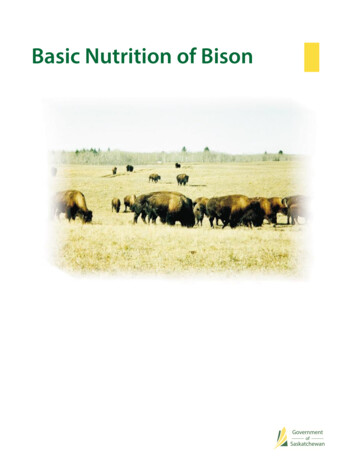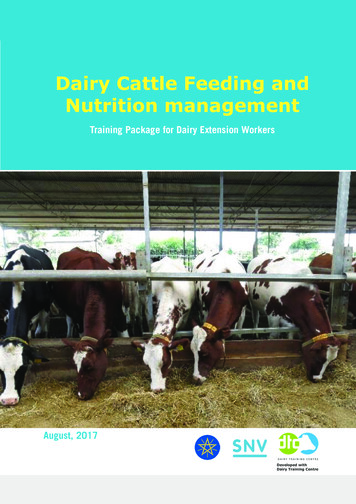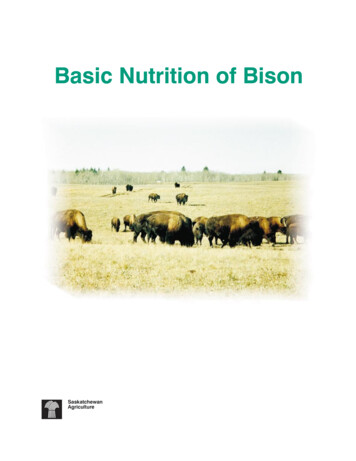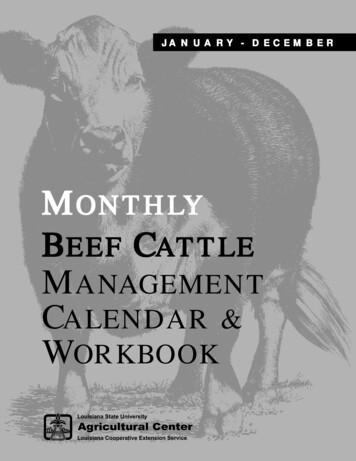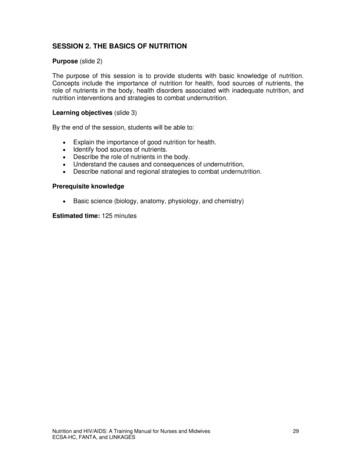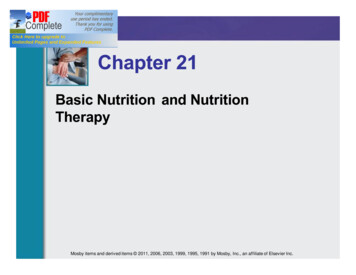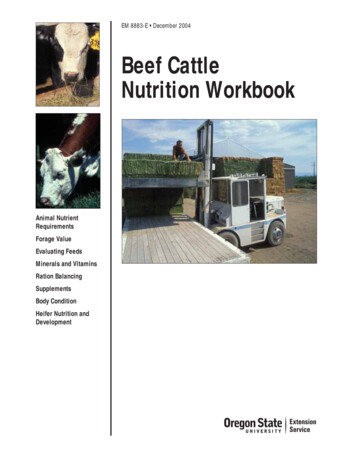
Transcription
EM 8883-E December 2004Beef CattleNutrition WorkbookAnimal NutrientRequirementsForage ValueEvaluating FeedsMinerals and VitaminsRation BalancingSupplementsBody ConditionHeifer Nutrition andDevelopment
ContentsThe Beef Cattle Nutrition Workbook is an interactive workbook to be usedin conjunction with Oregon State University Extension Service WinterNutrition Programs for beef producers.1. Animal Nutrient Requirements . 12. Forage Value . 193. Evaluating Feeds . 274. Minerals and Vitamins . 335. Ration Balancing . 416. Supplements and Supplementation Strategies . 497. Body Condition . 578. Heifer Nutrition and Development . 63 2004 Oregon State University. This publication may be photocopied or reprinted in its entirety fornoncommercial purposes.This publication was produced and distributed in furtherance of the Acts of Congress of May 8 andJune 30, 1914. Extension work is a cooperative program of Oregon State University, the U.S. Department of Agriculture, and Oregon counties.Oregon State University Extension Service offers educational programs, activities, and materials—without discrimination based on race, color, religion, sex, sexual orientation, national origin, age,marital status, disability, or disabled veteran or Vietnam-era veteran status. Oregon State UniversityExtension Service is an Equal Opportunity Employer.Published December 2004Beef Cattle Nutrition Workbook i
PrefaceThis Beef Cattle Nutrition Workbook is designed to be an interactivetool to help beef producers manage their herds. It contains informationabout beef cattle nutrient requirements, forage nutritive value, the importance of minerals and vitamins to cattle health and performance, balancing rations, economical supplementation strategies, heifer development,and the use of cow body condition score as a nutritional and reproductivemanagement tool. Each chapter includes a worksheet to help you developa ranch-specific plan for nutritional management of your beef herd. Wehope you find this workbook helpful in the planning and execution of yournutritional programs.EditorsDavid Bohnert, animal scientist, Eastern Oregon Agricultural ResearchCenter, Oregon State University (OSU), Burns, ORShelby Filley, regional livestock and forage specialist, OSU, Roseburg, ORCory Parsons, central Oregon livestock specialist, OSU, Prineville, ORRandy White, natural resources/district manager, Jackson Soil & WaterConservation District, Medford, OregonAuthorsDavid Bohnert, animal scientist, Eastern Oregon Agricultural ResearchCenter, OSU, Burns, ORDavid Chamberlain, Extension animal scientist, OSU, Harney County, ORShelby Filley, regional livestock and forage specialist, OSU, Roseburg, ORRon Hathaway, Extension animal scientist, OSU, Klamath County, ORJim Males, head, Department of Animal Sciences, OSU, Corvallis, ORBruce Nisley, agriculture instructor, Northwestern College, Powell, WYJames Oldfield, professor emeritus, Department of Animal Sciences, OSU,Corvallis, ORCory Parsons, central Oregon livestock specialist, OSU, Prineville, ORRobert Pawelek, Extension agent, The Ohio State UniversityGene Pirelli, Extension animal scientist, OSU, Polk County, ORMarni Porath, Extension livestock/range faculty, OSU, Malheur County, ORPeter Schreder, Extension livestock/range faculty, OSU, Lake County, ORBeef Cattle Nutrition Workbook ii
Animal Nutrient Requirements Chapter 1Animal NutrientRequirements1Shelby Filley andRobert PawelekProtein required (lb)Total digestible nutrients (lb)Different classes of animals have different requirements for totalpounds of feed (intake), energy, protein, vitamins, and minerals. As demonstrated in Figures 1.1 and 1.2, the specific amounts needed depend onthe animal’s stage of production and the level of performance desired bythe livestock manager. Requirements also may vary depending on previous diet. For example, when an animal has been on a limited diet and thenis fed a more nutritious diet, the diet is utilized more efficiently in a compensatory manner. Frame score (structural size) also influences requirements (see references, page 2).Water is another crucial part of a livestock nutrition program. Livestock should always have access to adequate quantities of good-quality,clean water. Lack of water leads to decreased feed intake, lower production, and reduced revenues. Water requirements for a cow–calf pair rangefrom 12 to 20 gallons per day. Yearling cattle require 6 to 14 gallons perday.Certain metals and contaminants are detrimental to livestock if present in water at significant levels. Test water to make sure the water is freefrom harmful materials (see references, page 2).Initial steps to evaluating livestock rations include: (1) describing theanimal, and (2) determining the animal’s nutrient requirements. NutrientWeight (lb)Figure 1.1—Protein requirements of medium-framedsteers at various weights and rates of gain.MonthFigure 1.2—Example of annual energy inputs fora spring-calving cow. Source: Zollinger, B. andD. Hansen. 2003. OSU Calving School Handbook,Animal Sciences publication 110. nd.pdfBeef Cattle Nutrition Workbook 1
Chapter 1 Animal Nutrient Requirementsrequirements for growing and finishing cattle (Table 1.1) and for breedingcattle (Table 1.2) are included on pages 5–17.A word of caution when using these tables: environmental factorssuch as mud, snow, cold, etc. increase nutrient requirements, particularlyfor energy. For instance, the critical temperature for most wintering cowsin eastern Oregon is around 30 F. When wind chill drops below 30 F, theenergy requirement increases. For each 1 F drop in wind chill, the energyrequirement increases by 1 percent. If the wind chill is 0 F, the energyrequirement required to maintain the cow increases by 30 percent. Also,cows in poor body condition take more energy for maintenance than cowsin good body condition (see Chapter 7).To begin an evaluation of your livestock-feeding program, fill in thefollowing worksheets using the appropriate tables.ReferencesBagley, C.V., J. Kotuby-Amacher, and K. Farrell-Poe. 1999. Analysis of WaterQuality for Livestock. CL602 in Cow–Calf Management Guide and CattleProducer’s Library. Agricultural Communications, College of Agricultural and Life Sciences, University of Idaho, Moscow, ID 83844-2332.Phone: 208-885-7839. Web: http://WBRC.ag.uidaho.edu/Bartlett, B. 1999. Watering Systems for Grazing Livestock. MichiganState University Extension Service. Available from Ben Bartlett,U.P. Experiment Station, 102 University Dr., Chatham, MI 49816.Phone: 906-439-5880. E-mail: bartlett@msue.msu.eduDansie, J.D., B. Bruce, and R. Torell. 2002. Frame Scores and Cattle FeederGrades. CL775 in Cow–Calf Management Guide and Cattle Producer’sLibrary. Agricultural Communications, College of Agricultural and LifeSciences, University of Idaho, Moscow, ID 83844-2332. Phone: 208-8857839. Web: http://WBRC.ag.uidaho.edu/National Research Council. 1984. Nutrient Requirements of Beef Cattle.National Academies Press, Washington, DC. Web: http://www.nap.edu/Zollinger, B. and D. Hansen. 2003. OSU Calving School Handbook, AnimalSciences publication 110. nd.pdf2 Beef Cattle Nutrition Workbook
Animal Nutrient Requirements Chapter 1Worksheet 1.1Nutrient Requirements for Growing and Finishing Cattle1. Animal descriptionFrame and sexGrowth characteristics (compensating or not)Animal weightDaily gain desiredAverage daily gain (final weight – current weight) days to gainClimatic and lot conditions (temperature, precipitation, mud, snow, etc.)2. Nutrient requirements (per day)—see Table 1.1Expected dry matter intake (DMI): poundsProtein: % in diet poundsEnergy, total digestible nutrients (TDN): % in diet poundsCalcium (% Ca)Phosphorus (% P)Beef Cattle Nutrition Workbook 3
Chapter 1 Animal Nutrient RequirementsWorksheet 1.2Nutrient Requirements for Breeding Cattle1. Animal descriptionSex and ageStage of pregnancy/lactationMilking ability (average 10 lb/day; superior 20 lb/day)Animal weightDaily gain desiredAverage daily gain (final weight – current weight) days to gain2. Nutrient requirements (per day)—see Table 1.2Expected dry matter intake (DMI): poundsProtein: % in diet poundsEnergy, total digestible nutrients (TDN): % in diet poundsCalcium (% Ca)Phosphorus (% P)4 Beef Cattle Nutrition Workbook
Animal Nutrient Requirements Chapter 1Table 1.1. Nutrient requirements for growing and finishing cattle (nutrient concentration in diet dry matter)aWeight(lb)Daily )TDN(lb)Ca(%)P(%)Medium-frame steer 2.90.490.26aDM dry matter; TDN total digestible nutrients (energy); Ca calcium; P phosphorusBeef Cattle Nutrition Workbook 5
Chapter 1 Animal Nutrient RequirementsTable 1.1. Nutrient requirements for growing and finishing cattle (nutrient concentration in diet dry matter)aWeight(lb)Daily )TDN(lb)Ca(%)P(%)Medium-frame steer calves 16.80.320.22Large-frame steer calves and compensating medium-frame yearling 16.91.9478.59.00.900.366 Beef Cattle Nutrition Workbook
Animal Nutrient Requirements Chapter 1Table 1.1. Nutrient requirements for growing and finishing cattle (nutrient concentration in diet dry matter)aWeight(lb)Daily )TDN(lb)Ca(%)P(%)Large-frame steer calves and compensating medium-frame yearling steers 521.110.42.1978.516.60.400.23Beef Cattle Nutrition Workbook 7
Chapter 1 Animal Nutrient RequirementsTable 1.1. Nutrient requirements for growing and finishing cattle (nutrient concentration in diet dry matter)aWeight(lb)Daily )TDN(lb)Ca(%)P(%)Large-frame steer calves and compensating medium-frame yearling steers ame .09.20.590.273.012.814.11.8176.59.80.690.318 Beef Cattle Nutrition Workbook
Animal Nutrient Requirements Chapter 1Table 1.1. Nutrient requirements for growing and finishing cattle (nutrient concentration in diet dry matter)aWeight(lb)Daily )TDN(lb)Ca(%)P(%)Medium-frame bulls .517.70.320.21Beef Cattle Nutrition Workbook 9
Chapter 1 Animal Nutrient RequirementsTable 1.1. Nutrient requirements for growing and finishing cattle (nutrient concentration in diet dry matter)aWeight(lb)Daily )TDN(lb)Ca(%)P(%)Large-frame bull calves and compensating large-frame yearling 60.660.304.013.815.62.1686.011.90.810.3710 Beef Cattle Nutrition Workbook
Animal Nutrient Requirements Chapter 1Table 1.1. Nutrient requirements for growing and finishing cattle (nutrient concentration in diet dry matter)aWeight(lb)Daily )TDN(lb)Ca(%)P(%)Large-frame bull calves and compensating large-frame yearling steers 17.00.400.244.020.211.32.3086.017.40.480.27Beef Cattle Nutrition Workbook 11
Chapter 1 Animal Nutrient RequirementsTable 1.1. Nutrient requirements for growing and finishing cattle (nutrient concentration in diet dry matter)aWeight(lb)Daily )TDN(lb)Ca(%)P(%)Large-frame bull calves and compensating large-frame yearling steers .430.25Medium-frame heifer .016.89.01.5177.012.90.280.2012 Beef Cattle Nutrition Workbook
Animal Nutrient Requirements Chapter 1Table 1.1. Nutrient requirements for growing and finishing cattle (nutrient concentration in diet dry matter)aWeight(lb)Daily )TDN(lb)Ca(%)P(%)Medium-frame heifer calves 0.220.19Large-frame heifer calves and compensating medium-frame yearling 2.60.380.22Beef Cattle Nutrition Workbook 13
Chapter 1 Animal Nutrient RequirementsTable 1.1. Nutrient requirements for growing and finishing cattle (nutrient concentration in diet dry matter)aWeight(lb)Daily )TDN(lb)Ca(%)P(%)Large-frame heifer calves and compensating medium-frame yearling heifers .18.21.8877.017.80.220.18Source: Adapted from National Research Council. 1984. Nutrient Requirements of Beef Cattle. National AcademiesPress, Washington, DC.14 Beef Cattle Nutrition Workbook
Animal Nutrient Requirements Chapter 1Table 1.2. Nutrients requirements of breeding beef cattle (nutrient concentration in diet dry matter).aWeight(lb)Daily )TDN(lb)Ca(%)P(%)Pregnant yearling heifers—last third of .911.70.290.211.920.08.81.865.113.00.320.21Dry pregnant mature cows—middle third of Dry pregnant mature cows—last third of 00.924.97.61.952.513.10.260.21aDM dry matter; TDN total digestible nutrients (energy); Ca calcium; P phosphorusBeef Cattle Nutrition Workbook 15
Chapter 1 Animal Nutrient RequirementsTable 1.2. Nutrients requirements of breeding beef cattle (nutrient concentration in diet dry matter).aWeight(lb)Daily )TDN(lb)Ca(%)P(%)Two-year-old heifers nursing calves—first 3 to 4 months postpartum—10 lb 320.231,0000.520.810.02.161.912.90.310.23Cows nursing calves—average milking ability—first 3 to 4 months postpartum—10 lb 40.270.221,4000.025.69.02.354.714.00.270.22Cows nursing calves—superior milking ability—first 3 to 4 months postpartum—20 lb ulls, maintenance and slow rate of growth—regain body condition 1,3001,3001,4001,5001,600For growth and development, use Table 016 Beef Cattle Nutrition Workbook
Animal Nutrient Requirements Chapter 1Table 1.2. Nutrients requirements of breeding beef cattle (nutrient concentration in diet dry matter).aWeight(lb)Daily )TDN(lb)Ca(%)P(%)Bulls, maintenance and slow rate of growth—regain body condition 00Source: Adapted from National Research Council. 1984. Nutrient Requirements of Beef Cattle. National AcademiesPress, Washington, DC.Beef Cattle Nutrition Workbook 17
Forage Value Chapter 2Forage Value2Ron Hathaway andGene PirelliLivestock producers in the western United States, including Oregon,are at an economic disadvantage relative to those in some other regionsin North America because of relatively high winter feed costs. A ruminantanimal consumes on average 2 to 3 percent of its body weight in dry matter each day. This equates to feeding 1.5 to 2.5 tons of conserved forage tomature cows or 0.25 to 0.5 ton to ewes during the winter feeding period.This volume of feed can represent more than 50 percent of the producer’sinput costs. The ability of Oregon cattle producers to compete with otherregions of North America may relate to how effectively they can reducewinter feed costs while maintaining acceptable levels of beef cattleproduction.In the grazing season, vegetative forage with an available height of4 to 8 inches usually provides the nutritional needs of livestock. Outside ofthe grazing season, however, livestock depend on the producer to provide for their nutritional needs. It is during this period, when animals arefed conserved forage, that the nutritional management program plays animportant part in maintaining the growth and condition of livestock.In order to provide a ration that meets the nutritional needs oflivestock, it is necessary to know the nutritive value of the forage. Foragevalue, whether hay or pasture, differs depending largely on stage of maturity, time, and weather at harvest.Vegetative growth is the leafy growth that occurs in the early andmiddle parts of the growing season, and it is the most nutritious forage.Reproductive growth is the seed-producing stage of growth. It occurslater in the growing season, is a characteristic of mature plants, and is ofreduced nutritive value.Even if forage is harvested at the proper time, the nutrient content ofthe resulting hay or silage can vary widely. The amount and type of fertilizer used and the composition of the stand can contribute to variability.Accurate forage analysis (see Chapter 3) is critical to profitable winter, nonpasture feeding programs. Even small deficiencies in protein andenergy can lead to lower-than-desired performance levels of animals.Once you determine the nutritive quality of the forage, you candecide how to allocate the feed. Ideally, you would formulate a completeand balanced ration, possibly including supplemental protei
Beef Cattle Nutrition Workbook _ii Preface This Beef Cattle Nutrition Workbook is designed to be an interactive tool to help beef producers manage their herds. It contains information about beef cattle nutr


